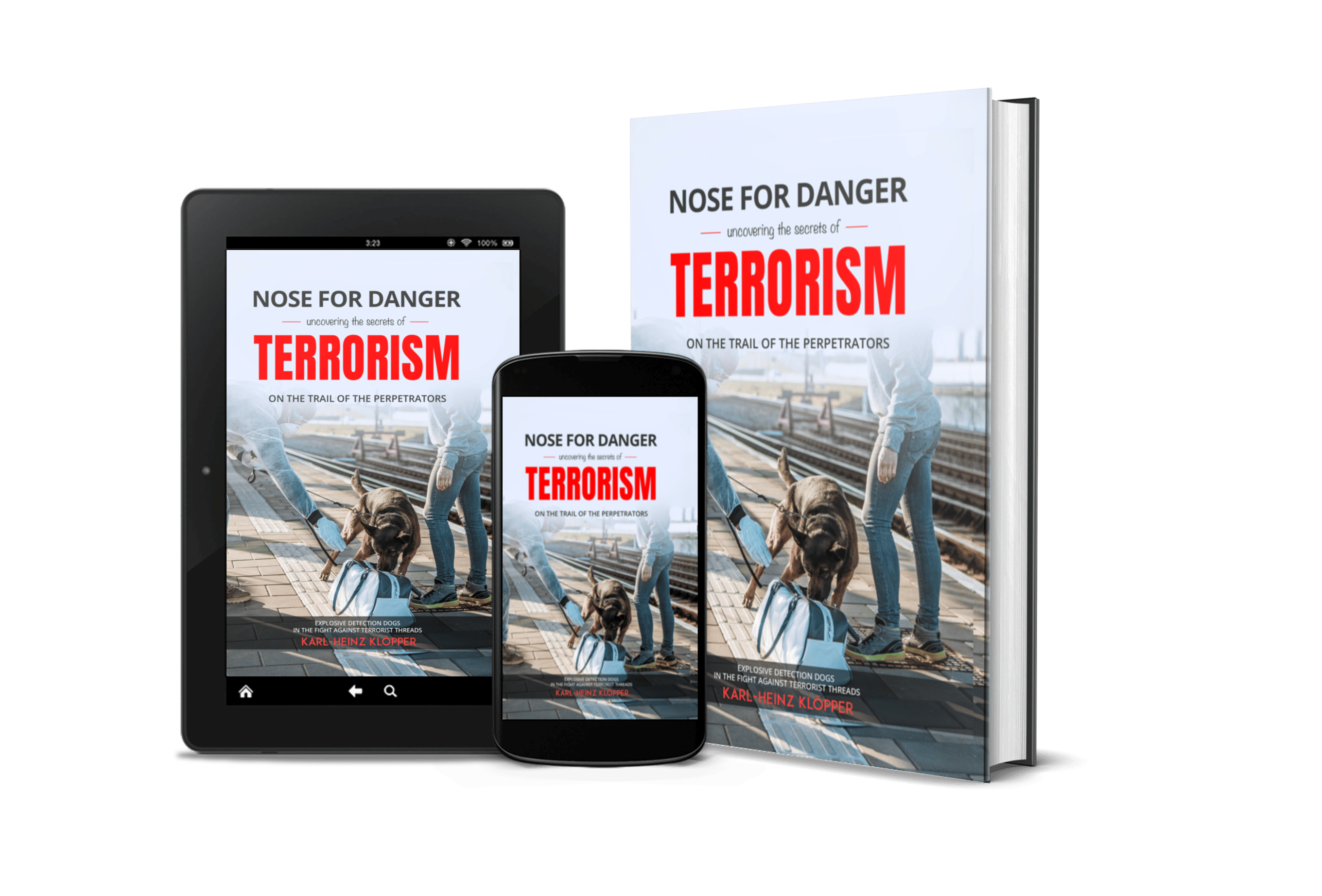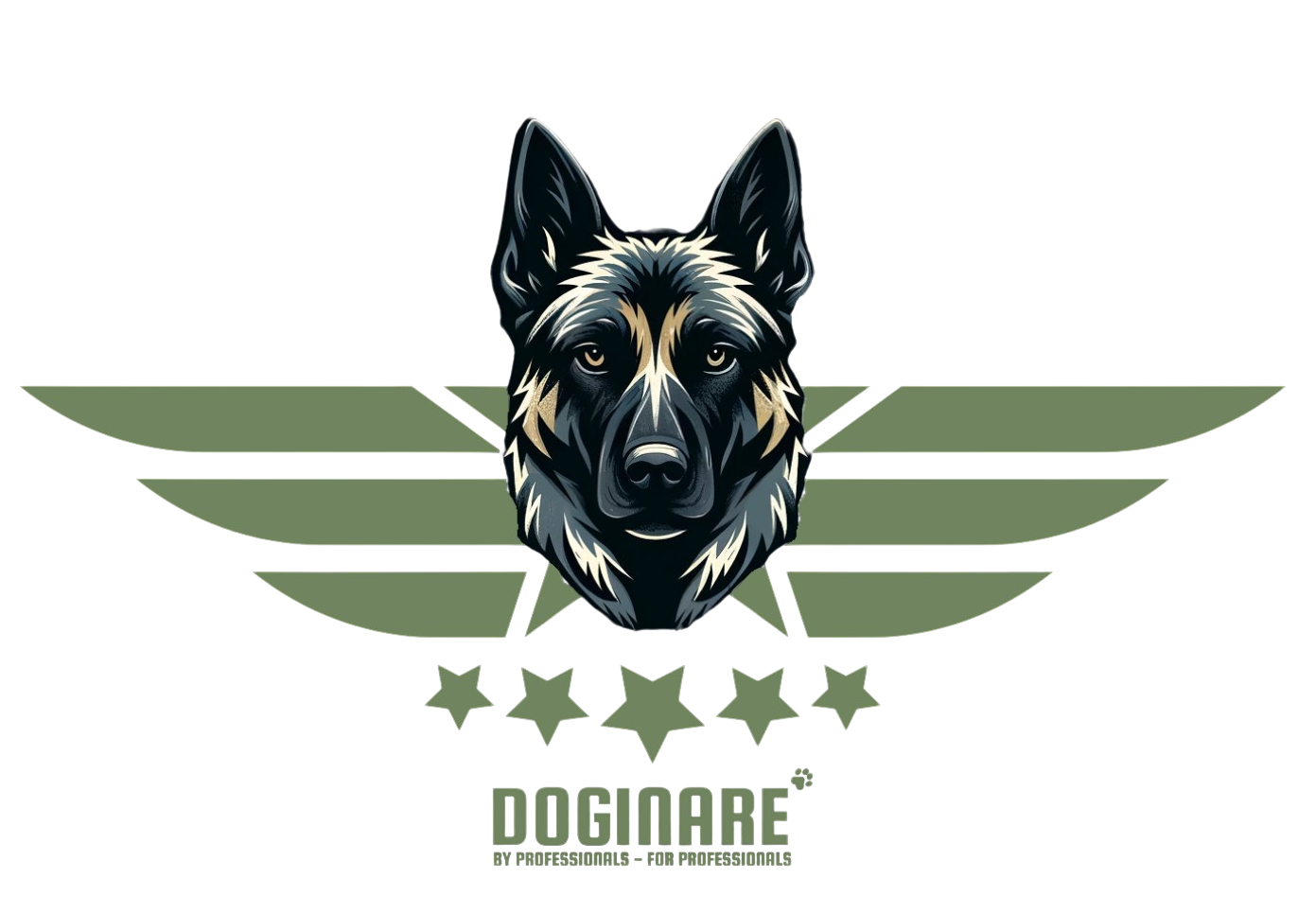Welcome to the world of „Nose for Danger uncovering the secrets of Terrorism“
A book that takes you on a breathtaking journey deep into the heart of terrorism and the lives of those who tirelessly stand at the forefront to protect us.
The complex network of terror is illuminated here – from politically motivated crime, state terrorism, left-wing and right-wing extremism, constitutional protection-relevant delegitimization of the state, foreign-related terrorism, to the self-administrators and Reich citizens.
And last but not least, the often overlooked yet devastating presence of Islamist terrorism. However, the protagonists in this multi-layered drama are not only humans.
At the center of this work stand the invisible heroes – the explosive detection dogs. With their remarkable ability to sniff out explosives, they play a crucial role in combating this global threat.
The book „Nose for Danger uncovering the secrets of Terrorism“ is a wake-up call reminding us that terrorism is not just a problem we see in the news, but a reality that occurs every day in our world.
It invites us to delve deeper into this issue and learn more about the various facets of terrorism that are often overlooked or seem too complex to understand.
This book is a journey into darkness to find the light.
It is a call to rethink and question our perceptions and understanding of terrorism.
„480 pages – 84 pages color illustrated“
Who is the book suitable for?:
Professionals in law enforcement and security:
These individuals work directly with the issues of terrorism and can benefit from a deeper understanding of the role of detection dogs and their training in combating terrorism.
Students and scholars in criminology and security studies:
This group can gain valuable insights from the deep dive into terrorism and related topics discussed in my book.
Dog handlers and trainers:
People who work with dogs, especially detection dogs, could benefit from the detailed information on the training and skills of detection dogs.
General audience with interest in social, political, and security-related issues: This group could be interested in the insights into the world of terrorism and the role of detection dogs in combating this threat.
Dog lovers and enthusiasts:
People who love and appreciate dogs might be interested in the special skills and the role of detection dogs in society.
Readers of non-fiction and true-crime books:
People who enjoy reading books about real events and crimes might be interested in the detailed insights and stories in my book.
Those interested in politics and human rights activists:
This group can benefit from the discussions on various forms of terrorism and their impacts on society.

The book can offer new perspectives to both professionals and laypeople, and contribute to the general discussion about terrorism, security, and the role of detection dogs. Fight terrorism with a deep understanding and tailored training for explosive detection dogs! This book does not provide rigid protocols, but instead puts the multifaceted training of explosive detection dogs in the context of real threats posed by terrorism. In a world where the face of the threat is constantly changing, you have the opportunity to adapt and improve your defensive strategies. Discover the potential of customized training options and prepare your detection dog to uncover even the most sophisticated bomb attack. This book is your ultimate compass in the fight against terrorism, a valuable tool to make your four-legged partner an unstoppable weapon against terrorism.
Chapter 1 – Explosives & Terrorism This chapter begins the discussion with a thorough examination of the historical development and various applications of explosives, from military purposes to use in terrorist attacks. It also covers the chemical basics of explosives and their classification. This is followed by a detailed analysis of peroxide and non-peroxide explosives and their fields of application. The second half of the chapter is dedicated to terrorism, particularly different forms such as right-wing extremism, left-wing extremism, and Islamist terrorism. Special attention is paid to potential threat scenarios through the use of explosives and strategies and patterns of behavior of terrorist organizations are examined. It also looks at the preferred explosives of terrorists, including ammonium nitrate, dynamite, and plastic explosives.
Chapter 2 – Ensuring Safety: Guidelines and Precautions in Handling Explosives This chapter begins with a discussion about legal provisions and regulations in the context of explosives. This is followed by a detailed consideration of the properties of explosives. The text then emphasizes the importance of safety measures and the influence of external factors on explosives. Next, the dynamics of explosions are examined and repeated references are made to legal regulation in dealing with explosives. The focus then shifts to the storage and transport of explosives in accordance with regulations, before discussing the legal and ethical aspects of dealing with explosives. The chapter ends with a deep dive into legal provisions for handling explosives.
Chapter 3 – The Complex World of Explosive Detection The chapter begins with an investigation of the capabilities of sniffer dogs and their sense of smell. It covers topics such as olfactory sensitivity, ability to concentrate under distractions, selection of puppies, and genetic quality assurance in the sniffer dog sector. Olfaction and its limits, as well as facts and myths about dogs‘ sense of smell, are extensively discussed. This is followed by the emphasis on lifelong learning and regular continuing education of sniffer dog teams. Then, the chapter delves into the chemical basics of odor profiling and the complexity of sniffer dog training. The focus then shifts to odor profiling on surfaces and olfactory landscapes from the dog’s perspective, as well as vapor pressure and its olfactory impact. The introduction to the Explosive Marking Act and the importance of tag components as invisible trademarks are covered. The section ends with a consideration of the purity level of explosives and a major focus on the top explosives in sniffer dog training.
Chapter 4 – Explosive Classes & Conditioning The chapter first addresses the distinction between uniform and composite explosives. This is followed by a guide to initial conditioning and working with similar substances. Special attention is given to the health hazards posed by explosives for detection dogs, including injuries and toxicity. The next section focuses on the emerging role of artificial intelligence (AI). It covers the potential of AI usage, techniques for pattern and image recognition, various AI applications in detection dog work, computer vision, natural language processing (NLP), deep learning, and data mining. Then, the processing and analysis of sound patterns, training and education with AI algorithms, and the automation of workflows are discussed. This is followed by a consideration of the challenges in combining detection dogs and AI, and ethical concerns. The section ends with a look at future prospects, including developments in detection dog training and AI applications, and future possibilities for sniffer dogs and AI. The last part of the chapter deals with the training of explosive detection dogs, including sniffer dog training techniques, the learning process & memory performance of detection dogs, long-term potentiation and long-term depression, the influence of noradrenaline and cortisol, and complex cognitive learning. This is followed by a discussion on initial conditioning & odor differentiation training.
Chapter 5 – Technology & Training The chapter starts with a discussion about the search board – quality differences and their influence on the result. This is followed by a consideration of the scent wheel for conditioning and the conditioning of a bridge signal. A significant section of the chapter focuses on the question: Food or play as reinforcement? Here, both food as a reward and toys as a reward are examined. The following sections are dedicated to play and food motivation and physiology, and proper conditioning of the food reward. Later, the scent wheel and emotions and the characteristics of scent wheel training are covered. Finally, the chapter turns to line-up training. Here, the process of line-up training and the advantages and disadvantages of line-up training are discussed.
Chapter 6 – Reliability Training This chapter deals extensively with decoy training. It starts with explaining the significance of decoy training in the education of detection dogs and the objectives of decoy training. It continues with the basics of decoy training and the role of irrelevant smells in decoy training. The sections on dosing and control of decoys, introduction of decoys, and methods for introducing decoys into training environments provide concrete instructions. It goes on to consider aspects of introducing decoys, the placement of decoys, and the importance of dosing and control of decoys. Other key topics are the gradual introduction of decoys into training, overcoming distractions by decoys and focusing on the smell of explosives, recognizing signs of distraction or irritation by decoys, and simulating real situations where decoys could be present. Finally, it deals with error correction during training, dealing with stress and fear during the training phase, and conditioning of large and small amounts of explosives.
Chapter 7 – Training Tools & Technologies This chapter addresses various aspects of training scent detection dogs. It begins with an overview of traditional training items and methods. Subsequently, innovative technologies for scent detection dog training are introduced to make the use of scent detection dogs more efficient and effective. Another important aspect covered in this chapter is the creation of contamination-safe training environments and materials that enable dogs to be provided with an unadulterated scent sample. In addition, the issue of contamination and its impact on the training of scent detection dogs is discussed. In this context, the phenomenon of absorption is particularly addressed.
Chapter 8 – Reliable Scent Samples This chapter focuses on the importance of reliable scent samples. It delves into various aspects of detection training sessions. A central theme is adsorbers, their use and how they work. The following topics are covered: Questions about the use of adsorbers as a scent sample: Examines the importance of adsorbers and their use in scent detection dog training.
The use of nitramines, nitro compounds, and nitric acid esters as actual substances: Discusses the role of these specific substances in relation to scent samples.
Loading and regeneration of adsorbers for scent samples: Discusses how adsorbers are loaded and regenerated to provide reliable scent samples.
Chapter 9 – Pseudo Scents vs. Real Substances This chapter focuses on the principle of pseudo scents: where they come from, how they work, and how they are applied. In addition, it explores what pseudo scents (scent imprints) are and how they can be used in the training of scent detection dogs.
Chapter 10 – Synchronicity in Training: Human and Dog as a Unit This chapter emphasizes the importance of effective communication between human and dog during training. A central focus is on creating clear images for effective training, allowing the human and dog to work together more harmoniously. A practical guide is introduced for methods to evaluate untrained dogs using the scent wheel system. The different expressions of indicator behavior in scent detection dogs are explained, including an introduction to the basic principles and various behaviors. There are detailed pieces of information about active indicators and the training methods and techniques necessary for their application. In a similar context, passive indicators are discussed, along with the corresponding training methods and techniques. The choice of indicator behavior, whether active or passive, is another important topic, including recommendations for choosing the appropriate indicator behavior. The chapter emphasizes the importance of unbiased testing procedures in scent detection work and explains the „blind“ and „double-blind“ methods. Finally, the influence of stress, perception, and emotions on the performance of scent detection dogs is examined, including a comprehensive consideration of the effect of acute stress situations on cognitive and emotional function in dogs, the physiological responses of the body to stress situations, and the complex cascade of physiological reactions to stress. The interaction between stress responses and olfactory perceptions is particularly highlighted, shedding light on the influence of stress on the sense of smell.
#DogTraining#ScentDetection#CanineTraining#DogAndHumanUnit#EffectiveCommunication#TrainingTechniques#ActiveIndicators#PassiveIndicators#ScentWheelSystem#BlindMethodTraining#DoubleBlindMethod#UnbiasedTesting#StressInDogs#OlfactoryPerceptions#ScentWork#DogBehavior#CanineCognition#StressResponses
#WorkingDogs#K9Unit

0 comments